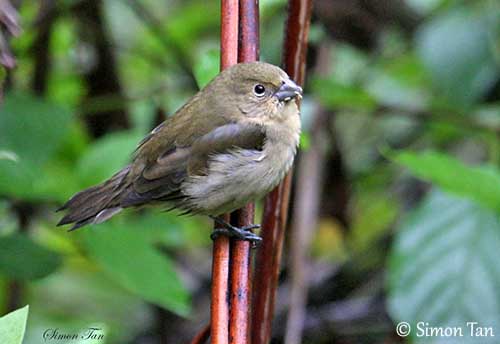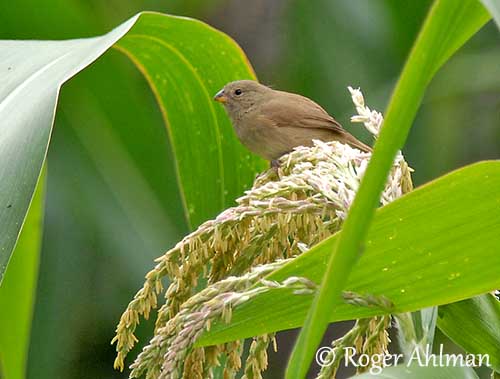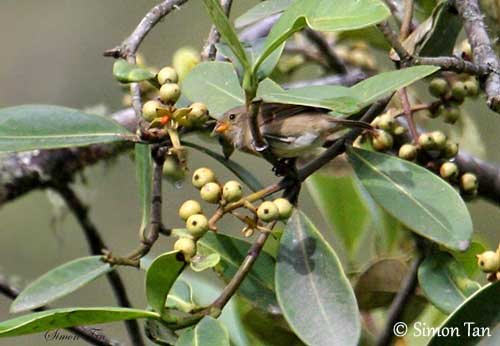
Fr: Sporophile obscur
All: Braungimpelfink
Esp: Semillero Oscuro - Espiguero pardo
Ita: Beccasemi oscuro
Nd: Bruine Grondvink
Sd: Brun gräsfink
Photographers :
Roger Ahlman
Pbase Galleries Peru and Ecuador
Simon Tan
PBase Bird galleries
Text by Nicole Bouglouan
Sources :
HANDBOOK OF THE BIRDS OF THE WORLD Vol 16 by Josep del Hoyo- Andrew Elliot-David Christie – Lynx Edicions – ISBN: 9788496553781
BIRDS OF SOUTH AMERICA – Passerines - by Robert S. Ridgely and Guy Tudor – HELM Field Guides – ISBN: 9781408113424
A GUIDE TO THE BIRDS OF COLOMBIA by Steven L. Hilty and William L. Brown - Princeton University Press – ISBN 069108372X
BirdLife International (BirdLife International)
Sato, A., Tichy, H., O’hUigin, C., Grant, P. R., Grant, B. R. & Klein, J. (2001). On the origin of Darwin’s Finches. Mol. Biol. Evol. 18(3): 299-311.
Molecular Biology and Evolution
AVES ARGENTINAS – Asociación Ornitológica del Plata
Neotropical Birds – Cornell Lab of Ornithology
Dull-colored Grassquit
Tiaris obscurus
Paseriformes Order – Thraupidae Family
INTRODUCTION:
The Dull-colored Grassquit is currently identified as the nearest living species relative of the Darwin’s Finches.
Formerly classified in the genus “Sporofila”, it is today in the genus “Tiaris”. This change is due to the examination of the skeletal anatomy of this bird, and to molecular data.
The Tiaris group has been identified as the sister group of the Geospizinae, through genetic tests and genealogical reconstruction.
The Dull-colored Grassquit shows several behavioural similarities with the Darwin’s Finches such as habitat, diet and nesting (with same type of nest). It probably arrived in the Galapagos Islands from Central or South America.
However, the true question is: Is the Dull-colored Grassquit the ancestor of the Darwin’s Finches?
We have two answers:
Maybe next day we will be able to know, with more detailed studies.
DESCRIPTION OF THE BIRD:
Biometrics:
Length: 11-12 cm
Weight: 11 g
The adult of nominate race of extreme S of range is brownish overall with browner wings and tail, and paler underparts. Throat, breast and upper flanks are more greyish-brown. The undertail-coverts are tinged rusty-brown.
On the head, we can see a narrow, dull, paler supercilium and a darker eyeline. The face may sometimes show a greyish wash.
The bill is short, conical, with fairly straight culmen. It is dark with yellowish base of lower mandible, but the colour varies throughout the year, according to the breeding states. The eyes are dark brown, with pale crescents above and below. Legs and feet are brownish.
Both sexes are similar, and the juvenile resembles adults.
The nominate race varies according to the range. It is darker grey-brown on the breast in C and S Peru and adjacent Bolivia, involving a contrast with the pale belly. The birds from W Slope of La Paz S to Argentina are pale like the N Peruvian birds.

SUBSPECIES AND RANGE:
We can find four subspecies which differ in plumage and bill coloration.
T.o. haplochroma occurs in the mountains of N Colombia and N Venezuela, also Andes S to Colombia.
This race is more uniform, with darkest underparts than other subspecies. There is no contrast between breast and belly. It is the only one with entirely dark bill.
T.o. pauper is found in extreme S Colombia, S on the W slope of the Andes to NW Peru, and on the E slope in N Peru.
This race in northern range (extreme S Colombia and Ecuador) has two-tone bill with pale lower mandible, pale brown breast and pale cream belly, with contrasting buff flanks.
In S (N Peru from W slope of Andes), it has greyish breast, pale flanks and belly, and sometimes whitish throat.
T.o. pacificus occurs on the coastal plain and slope in Peru, from Ancash S to Arequipa.
This one is large and pale, and resembles N Peruvian previous race.
T.o. obscurus (described above) is found on E slope of C Peru, and S through the Andean slopes of Bolivia to NW Argentina. It also occurs outside the breeding season in E lowlands of Bolivia, W Paraguay and N Argentina.
HABITAT:
The Dull-colored Grassquit frequents the edges of the open forest, lowlands, shrubby clearings, moist woodlands, thickets along the roads, dry scrubs and gardens too.
The species is visible between 500 and 2100 metres of elevation.
CALLS AND SONGS: SOUNDS BY XENO-CANTO
The Dull-colored Grassquit’s call is a high-pitched “ti”. The song is an explosive buzz “zeetig-zeezeezig” in Peru where it is considered similar to that of the Blue Black Grassquit (Volatinia jacarina), but longer, more melodious and more complex too. The song may vary according to the range, but it usually consists of some rapid introductory notes, followed by short trill or whistles.

BEHAVIOUR IN THE WILD:
The Dull-colored Grassquit feeds on seeds of grasses (Panicum). It forages on the ground, and stays rather low like other seedeaters. It may bend down the grass-heads and other seedheads to reach the seeds. It forages usually within the cover of the understorey. It moves by hopping and running.
It can be found alone or in pairs, but also in small flocks, rarely with other species.
The Dull-colored Grassquit is monogamous. The male is territorial during the breeding season. It probably performs flight displays like many New World species. The male sings from exposed perches.
This species is resident in most parts of the range. Some populations of Bolivia are presumed altitudinal migrants, that indicates an E-W movement in extreme S of the range. There are some records in SW Brazil (Mato Grosso).
The flight is usually direct and slightly undulating.
REPRODUCTION OF THIS SPECIES:
The breeding season starts in January/February in Bolivia and Argentina, but there are some variations according to the range.
This species often builds the nest in close vicinity of swarming wasps Polistes (Vespidae), within one metre from the swarm. Other nests can be placed close to nettle for better protection.
It is usually placed in tree, especially Schinopsis balansae, and sometimes in bush. It is built in a triple fork of branches, between 3 and 4, 50 metres above the ground.
This is a dome-shaped structure with a large rounded side entrance and with small overhang over this entrance. It is made with plant fibres.
The female lays 3-4 whitish eggs with pale and dark brown markings.
No other available information.

PROTECTION / THREATS / STATUS:
The Dull-colored Grassquit can be uncommon to locally common. This species has large range and the population is suspected to be increasing, taking advantage of new suitable areas due to habitat degradation.
The species is rare in most Peruvian range, but increasing in Ecuador while in Venezuela, it is vulnerable to human developments, through urbanization.
But currently, the Dull-colored Grassquit is not globally threatened.